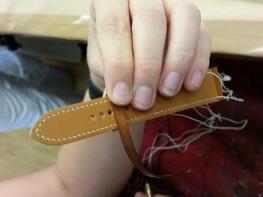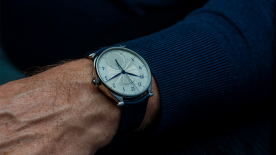You can spend an entire morning in the ground-floor workshops of the Hermès facility in Brügg without seeing a single watch. This is because the workshops here have been dedicated to the production of the brand’s signature leather watch straps since 2006.
Every single step in the manufacturing process is carried out inside these walls, from the first cut of the skin, taken from a temperature-controlled storage room, to the final stitch and the finishing touch, when the letter corresponding to the year of production is embossed on the inside of the strap.
Skins and tanning
A Hermès leather watch strap can be fashioned out of alligator, goatskin or ostrich, not forgetting the Barenia calfskin that is so typical of the brand – supplied by a tannery in Alsace that uses a vegetable-based tanning process that does not hide imperfections in the skin. Across the entire Hermès collection, some 2000 different colours of leather are available, of which 50 different options are available for the leather watch straps for Hermès timepieces. A further 300 different options for sizing create a mind-blogging amount of permutations for the leather craftsman to deal with.
So what does make the leather straps produced by Hermès so special? Quite simply, it is the level of care and attention that the craftsmen here in the workshop lavish on each strap, ensuring that it not only meets the brand’s stringent quality criteria, but also that it is produced and finished in a way that will make it last.
Total control
The fact that all the operations are carried out in-house undoubtedly gives Hermès the edge in ensuring the high-quality of its leather straps. From the very first step, when the leather is pre-cut and paired up to ensure that the texture matches for both ends of the strap, the focus is on the aesthetic. No wrinkles, veins or scratches are tolerated and any areas of leather with such imperfections are discarded. This can lead to a lot of waste, but Hermès cannot sell its leather off-cuts either, for fear of them ending up on the market as “Hermès” leather. They are therefore incinerated locally to provide district heating.
The work then becomes painstaking and is carried out mainly by hand as the viledon fabric is inserted between the front and back sides of the strap, the leather is dressed and tapered and then hand stitched with the signature Hermès inclined saddle stitch that is used on all Hermès articles. The flax thread is also passed through the last two stitching holes in both directions simultaneously to make the stitching stronger than a machine stitch.
The sides of the leather are then softened with sandpaper and dyed using ink made to a secret recipe. These two processes often need to be repeated in order to achieve the quality levels required. In between the two stages, the edges of the strap are heat pressed in order to seal them. After polishing the strap edges with wax (heated by hand with the friction from a cloth) and sealing with paraffin, the two loops (one fixed, one mobile) are produced and finished in the same way to complete the strap, with “H”-shaped stitching used on the underside of the loop as a kind of secret signature.
Only once these steps have been completed to the satisfaction of the individual craftsman are the straps submitted for quality control, where – if they pass – the final touch is added: a discreet letter stamped on the underside of the strap indicating its year of production.
Click on the image above for a comprehensive photo gallery of Hermès leather watch strap production.





